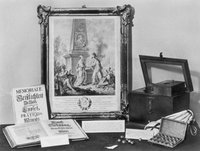A long history: Holy Years, nineteenth-century historical jubilees, and twentieth-century commemorative celebrations
European cultures of commemoration as we know them today have a history: their origins lie in the Judeo-Christian tradition and were secularized only in the context of the Reformation. The nineteenth century was so enthusiastic about such celebrations that it has even been dubbed the “century of jubilees.”
From the Old Testament to medieval Holy Years
Commemorations of institutions or foundings at regular intervals of 10, 20, 25, 50, or 100 years appear so natural to us today that our public culture of remembrance, celebration, and exhibition would be unthinkable without jubilees. In the private sphere, too, the cyclical recurrence of anniversaries is celebrated in birthdays or anniversaries without further reflection, evidence of an almost unquestioned combination of tradition and convention.
Questions about the origin of the Christian jubilee tradition are usually answered with reference to the Old Testament: according to Leviticus 25:8–31, a sabbatical year, or “jubilee year,” should follow seven cycles of seven years. In this seventh year, all people were to return to their property and family; slaves were to be freed; and sowing and harvesting were to cease for a year. The concept of the Jewish jubilee year was incorporated into Christian practices of indulgence in the Middle Ages. With the introduction of the first Holy Year by Pope Boniface VIII in 1300, a mechanism was established that became crucial for the jubilee cycle and represented, in the view of medieval theologians, a qualitative improvement: spiritual – rather than earthly – debts were to be forgiven in the Christian jubilee year.
The massive influx of pilgrims during the Holy Year of 1300 led to changes in the originally set 100-year interval between Holy Years. Since 1475, a Catholic Holy Year has been held every twenty-five years, establishing a standard cycle of jubilees that is still in effect today; the practice of thirty-year celebrations only became common in the nineteenth century. The papacy’s invention and regulation of the Holy Year vividly illustrate its “control over time” in the pre-Reformation context, and the church’s dominance over how time was structured included a monopoly on setting feast days. To avoid suspicion of challenging papal authority, dates for celebrating secular-historical events could be established in secret, if at all.
Reformation and counterreformation
It is thus unsurprising that competition for the power to structure time emerged from the confessional opposition starting in the sixteenth century. A key impetus for the pluralization and secularization of jubilee culture came from early university jubilees. The Reformed universities of Tübingen, Heidelberg, Wittenberg, and Leipzig distanced themselves, with their celebrations in the late sixteenth and early seventeenth centuries, from Roman Catholic jubilee culture, initiating a competing culture of commemoration. The grand celebrations of the 100th anniversary of Luther’s theses in 1617 and the 100th anniversary of the Peace of Augsburg in 1655 also highlighted a sharp ideological separation from papal jubilees and their celebration of indulgences.
During the Enlightenment, historical events deemed particularly significant for human history were celebrated as jubilees, and authorities soon recognized the advantage of such public commemorations. Beginning in the late eighteenth century, both the bourgeoisie and ruling houses regularly held jubilees as forms of public representation. By the mid-nineteenth century, city jubilees had become a crucial part of urban-bourgeois festival culture. The question of to what extent these upper-class celebrations were influenced by Roman secular celebrations has yet to be examined in sufficient detail.
In the twentieth century, alongside a jubilee culture that continued to focus on positive events, the notion of jubilees also underwent a shift. “Difficult commemorations” (Winfried Müller) emerged as the cyclical remembrance of negatively connotated political events. In the context of the twentieth century’s disasters, remembering and forgetting took on new significance in historiography and public discourse. For occasions marking anniversaries such as the rise to power of Adolf Hitler, it is more accurate to speak of periods of remembrance, analogous to earlier cycles of commemoration, rather than jubilees as such, since they evoke a periodic commemoration of certain events that complements the linear and cyclical experience of human time.



